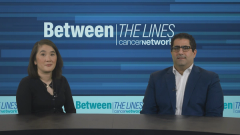
Overview of EGFR Exon 20 Mutations
Joshua K. Sabari, MD, and Helena A. Yu, MD, experts on non–small cell lung cancer, give an overview of EGFR exon 20 insertion mutations.
Episodes in this series

Transcript:
Joshua K. Sabari, MD: Welcome to this CancerNetwork®Between the Lines program. Today’s feature poster presented at the 2023 European Lung Cancer Congress is titled, “Amivantamab vs Alternative Real-World Anti-Cancer Therapies in Patients With Advanced Non–Small Cell Lung Cancer With Epidermal Growth Factor Receptor Exon 20 Insertion Mutations in the US and Europe.” I’m Dr Joshua Sabari, a thoracic medical oncologist at NYU [New York University] Langone Health Perlmutter Cancer Center in New York City, New York, and I’ll be discussing this article with my colleague Dr Helena Yu. Dr Yu, please introduce yourself.
Helena A. Yu, MD: Hi everyone. I’m Helena Yu, a medical oncologist at Memorial Sloan Kettering Cancer Center in New York, New York.
Joshua K. Sabari, MD: Welcome to this discussion today. Let’s jump right in. For EGFR exon 20 insertion mutations, how common are these and how often do you pick this up in your clinic?
Helena A. Yu, MD: In my practice, and I think generally, EGFR mutations as a whole are about 15% to 20%, and I would say probably 2% to 3% of those are these EGFR exon 20 insertions.
Joshua K. Sabari, MD: We see a lot of EGFR mutations in the clinic. Differentiate for me the common EGFR mutations, exon 19/21 vs these EGFR exon 20 insertion mutations, which you mentioned occur a bit less frequently.
Helena A. Yu, MD: Sure. I think it is confusing, and the nomenclature on some of those next-generation sequencing [NGS] reports can be hard to decipher. The original mutations that were sensitizing that had the first approvals for EGFR-directed therapy, were as you said, Josh, the L858R and exon 19 deletions. In addition to that, there are some rare EGFR mutations like exon 18 that still have some sensitivity to the traditional EGFR inhibitors. Then there are exon 20 insertions, which are all in exon 20. We can talk a bit about position there later, I’m sure. But those have recent approvals of new therapies including amivantamab, which we’re talking about today.
Joshua K. Sabari, MD: It’s an exciting space and exciting time. Historically you’d see an EGFR mutation, exon 19 or 21, and you thought, great, I have a lot of therapeutic options. But when we saw EGFR exon 20 insertion mutations, these were really resistant to our classical targeted therapies. We know that’s now changed and we have many options. Before jumping into therapies, how are you identifying these EGFR exon 20 insertion mutations in your practice?
Helena A. Yu, MD: Clinically, if you have the right phenotype of patient, you think there’s a good chance you’ll have a mutation. Historically, when we did get that EGFR exon 20 insertion result back, we have to say, oh, it’s not that type of mutation. But it’s obviously good news with these new drugs. At my institution, we use next-generation sequencing, and that allows us to look for all the mutations within the EGFR gene but also look for other driver mutations. So, it’s 1 test to identify all. What about you?
Joshua K. Sabari, MD: We’re also using broad panel next-generation sequencing, but a lot of times I see clinicians in the community using IHC [immunohistochemistry]-based assays. What’s the problem with that?
Helena A. Yu, MD: I think they are not sensitive. Traditionally the antibodies I’m aware of are for L858R and the 15 base pair exon 19 deletion, and so you miss a lot of different EGFR mutations if you focus on that.
Joshua K. Sabari, MD: I agree. So, EGFR exon 19 and exon 21, those are the common mutations. Those are specific mutations that you pick up using IHC-based assays. You can also pick them up on NGS. Now EGFR exon 20, is that 1 type of mutation or 1 mutation, or are there many mutations that make up that group?
Helena A. Yu, MD: That is the challenge because depending on how the reports annotate these, you might not know exactly if this is an EGFR exon 20, and if it is, is it the type that we know is sensitive to these new inhibitors? I think that generally, there are 3 areas of the EGFR exon 20. There’s the near loop, there’s the far loop, and then there’s the helical domain. I think there is some nuance in terms of mutations in those different places, but all of those respond to these EGFR exon 20 inhibitors that we’re going to talk about.
Joshua K. Sabari, MD: What I’m hearing is that EGFR exon 19/21 is a unique subset, that’s the common alterations. When we talk about EGFR exon 20 insertion mutations, clearly, it’s a different entity, and there are many EGFR exon 20 insertion mutations. But it sounds like across the board, all of those insertion mutations may be responsive to amivantamab. We’ll talk a little about the data.
Transcript edited for clarity.
Newsletter
Stay up to date on recent advances in the multidisciplinary approach to cancer.



















































































